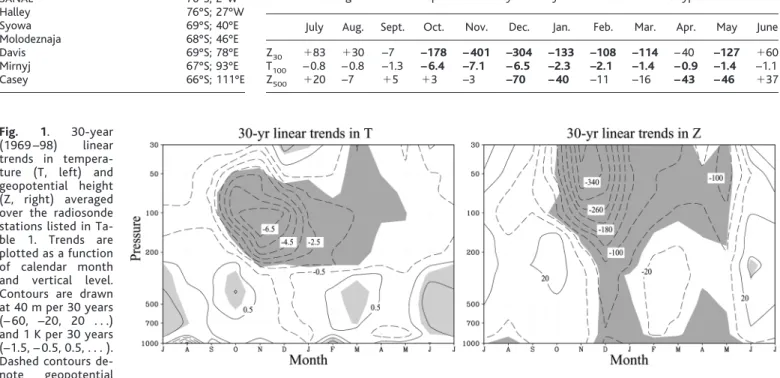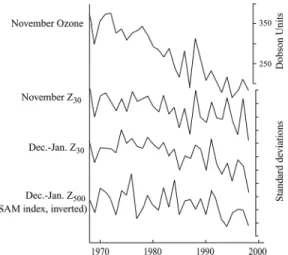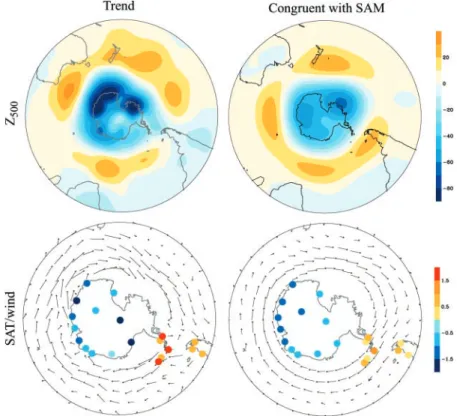over many micrometers. Inorganic ZnS nano- crystals were confined at junction areas where two adjacent lamellar layers met. Fluorescent imaging of the film (Fig. 4C) exhibited a pat- tern of ⬃ 1 m fluorescent lines, corresponding to the ZnS nanocrystals arranged in the film. In a control viral film, without ZnS crystals, no fluorescence was observed (18). Because freely suspended liquid crystalline films form highly ordered structures on the free surface as a result of surface forces (25), smectic O herringbone patterns on the film surface might have higher order than the smectic A or smectic C within inner areas in this film. The observed smectic O morphology of the A7-ZnS film is similar to the high-ratio rod-coil (f
rod-coil⬎ 0.96) block co- polymers, which favor the bilayered and inter- digitated morphologies (6). This similarity to A7-ZnS structure (f
phage-nanocrystals⫽ ⬃ 0.98) strongly suggests that the A7-ZnS might have interdigitated morphology, where the director (bacteriophage axis) flips by 180° between ad- jacent A7-ZnS particles in the film. Consider- ing the packing free energy, the interdigitated structure might be the most stable structure for the particles having a larger head (20-nm nano- crystal aggregates) and extremely long rod tail particles (Fig. 3, A and B). A schematic dia- gram of the A7-ZnS film is shown in Fig. 4E.
The mechanism for the formation of self- assembled smectic-like lamellar structure of the A7-ZnS film is still being investigated. The morphologies we observe in the film are similar to the results of earlier experiments and theoret- ical work on rigid and flexible block copolymers (6, 26). The A7 phage recognize and physically bind ZnS nanocrystals, preventing macro phase separation into separate organic and inorganic blocks. As the solvent is gradually removed, the virus particles develop orientational order within the suspension and the smecticlike lamellar structure begins to grow from several nucleation points. The mesomorphic structure in the sus- pension is retained even after the complete evaporation of the solvent and forms the highly ordered self-supporting viral film.
Our approach to aligning nanocrystals in a genetically engineered phage-based liquid crys- tal system has several advantages. Monodis- perse biopolymers of specified lengths (A7 phage) can be easily prepared by molecular cloning techniques. By genetic selection of a peptide recognition moiety, one can easily modulate and align different types of inorganic nanocrystals in 3D layered structures (27). Ad- ditionally, we have found that the viral films can be stored at room temperature for at least 7 months without losing the ability to infect a bacterial host and with little loss of titer. This finding indicates that the fabrication of viral film is a reversible process. Moreover, we be- lieve that the film fabrication may constitute a new process for storage of high-density engi- neered DNA. We anticipate that our approach, using recognition as well as a liquid crystalline
self-ordering system of engineered viruses, may provide new pathways to organize electronic, optical, and magnetic materials.
References and Notes
1. J. P. Mathias, E. E. Simanek, G. M. Whitesides, J. Am.
Chem. Soc. 116, 4326 (1994).
2. X. Duan, J. Wang, C. M. Lieber, Appl. Phys. Lett. 76, 1116 (2000).
3. D. J. Norris, M. G. Bawendi, Phys. Rev. B 53, 16347 (1996).
4. C. E. Fowler, W. Shenton, G. Stubbs, S. Mann, Adv.
Mater. 13, 1266 (2001).
5. S. M. Yu et al., Nature 389, 167 (1997).
6. J. T. Chen, E. L. Thomas, C. K. Ober, G.-P. Mao, Science 273, 343 (1996).
7. T. Douglas, M. Young, Nature 393, 152 (1998).
8. A. P. Alivisatos et al., Nature 381, 56 (1996).
9. C. A. Mirkin, R. L. Letsinger, R. C. Mucic, J. J. Storhoff, Nature 382, 607 (1996).
10. P. V. Braun et al., J. Am. Chem. Soc. 121, 7302 (1999).
11. Z. Dogic, S. Fraden, Phys. Rev. Lett. 78, 2417 (1997).
12.
㛬㛬㛬㛬, Langmuir 16, 7820 (2000).
13. J. Lapointe, D. A. Marvin, Mol. Cryst. Liq. Cryst. 19, 269 (1973).
14. S. A. Issaenko, S. A. Harris, T. C. Lubensky, Phys. Rev.
E 60, 578 (1999).
15. S. R. Whaley, D. S. English, E. L. Hu, P. F. Barbara, A. M.
Belcher, Nature 405, 665 (2000).
16. C. E. Flynn, C. Mao, J. L. Williams, B. A. Korgel, A. M.
Belcher, in preparation.
17. C. Mao, C. E. Flynn, A. M. Belcher, in preparation.
18. Supplementary data are available on Science Online at www.sciencemag.org/cgi/content/full/296/5569/
892/DC1.
19. The highest concentration of A7-ZnS suspension was prepared by adding 20 l of 1 mM ZnCl
2and Na
2S solutions, respectively, into the ⬃30 mg of phage pellet after centrifugation. Various A7-ZnS suspensions were prepared by diluting the smectic A7-ZnS suspensions.
Their concentrations were measured by ultraviolet ab- sorption spectroscopy at 269 nm. These suspensions were transferred to cover slips and 0.7-mm glass capil- lary tubes and characterized.
20. G. W. Gray, J. W. G. Goodby, Smectic Liquid Crystals (L. Hill, Glasgow, 1984), pp. 23–44.
21. One drop of dilute suspension was applied to a TEM grid, washed with distilled water, and quickly dried.
Some samples were stained with 2% uranyl acetate to observe bacteriophage.
22. Bacteriophage pellets were suspended with 400 l of tris-buffered saline ( TBS, pH 7.5) and 200 l of 1 mM ZnCl
2to which 1 mM Na
2S was added. After rocking for 24 hours at room temperature, the suspension, which was contained in a 1-ml microcentrifuge tube, was slowly dried in a dessicator for 1 week.
23. A7-ZnS films were observed by SEM. For SEM anal- ysis, the film was fractured, then coated via vacuum deposition with 2 nm of chromium in an argon atmosphere.
24. The film was embedded in epoxy resin (LR white) for 1 day and polymerized by adding 10 l of accelerator (London Resin Co. Ltd.). After curing, the resin was thin-sectioned with a Leica Ultramicrotome; ⬃50-nm sections were floated on distilled water and picked up on blank gold grids.
25. A. A. Sonin, N. Clark, Freely Suspended Liquid Crys- talline Films, (Wiley, New York, 1998), pp. 25–43.
26. N. Semenov, S. V. Vasilenko, Sov. Phys. JETP 63, 70 (1986).
27. Although our liquid crystal systems have only incor- porated ZnS at present, our group has already select- ed phage with specific peptide recognition to, and nucleation control of, many materials including II-VI semiconductor crystal surfaces (CdS, PbS, CdSe, ZnSe) and other magnetic materials. Therefore, liquid crystal systems using these and other materials are possible and currently being investigated.
28. We thank J. Williams for assistance in amplifying the clones, J. Mendenhall for assistance in preparation of samples for TEM, J. Ni for assistance in AFM analysis for the cast film, and D. Margolese and E. Ryan for assistance in manuscript editing. The Core TEM and SEM Facilities were used in the Texas Materials Institute, the Center for Nano- and Molecular Science and Technology, and the Institute for Cellular and Molecular Biology. Supported in part by the Army Research Office (Presidential Early Career Award in Science and Engineering), NSF (Nanoscale Interdisciplinary Research Teams), and the Welch Foundation.
14 November 2001; accepted 20 March 2002
Interpretation of Recent Southern Hemisphere
Climate Change
David W. J. Thompson 1 * and Susan Solomon 2
Climate variability in the high-latitude Southern Hemisphere (SH) is dominated by the SH annular mode, a large-scale pattern of variability characterized by fluctuations in the strength of the circumpolar vortex. We present evidence that recent trends in the SH tropospheric circulation can be interpreted as a bias toward the high-index polarity of this pattern, with stronger westerly flow encircling the polar cap. It is argued that the largest and most significant tropospheric trends can be traced to recent trends in the lower stratospheric polar vortex, which are due largely to photochemical ozone losses. During the summer-fall season, the trend toward stronger circumpolar flow has contrib- uted substantially to the observed warming over the Antarctic Peninsula and Patagonia and to the cooling over eastern Antarctica and the Antarctic plateau.
The atmosphere of the SH high latitudes has undergone pronounced changes over the past few decades. Total column ozone losses have exceeded 50% during October throughout the 1990s (1–3), and the Antarctic ozone “hole”
reached record physical size during the spring
of 2000 (4). The lower polar stratosphere has
cooled by ⬃ 10 K during October-November
since 1985 (5, 6), and the seasonal breakdown
of the polar vortex has been remarkably de-
layed: from early November during the 1970s
to late December during the 1990s, in both the
troposphere (7) and the lower stratosphere (1, 7–9). At the surface, the Antarctic Peninsula has warmed by several K over the past several decades, while the interior of the Antarctic con- tinent has exhibited weak cooling (10, 11). Ice shelves have retreated over the peninsula and sea-ice extent has decreased over the Belling- shausen Sea (12–14 ), while sea-ice concentra- tion has increased and the length of the sea-ice season has increased over much of eastern Ant- arctica and the Ross Sea (14–16). Here, we offer evidence that illuminates the connections between these seemingly disparate trends.
We examine climate trends in the high- latitude SH using 30 years (1969 –1998) of monthly mean radiosonde data from seven sta- tions located over Antarctica (Table 1), 32 years (1969 –2000) of monthly surface temper- ature data observations, 30 years (1969 –1998) of ground-based total column ozone measure- ments from Halley station, and 22 years (1979 – 2000) of tropospheric geopotential height data from the National Centers for Environmental Prediction/National Center for Atmospheric Research (NCEP/NCAR) reanalysis (17 ). The
choice of periods used in the analysis was mo- tivated by the facts that (i) the radiosonde and surface temperature records are most complete after ⬃ 1969, (ii) the radiosonde data are only available through 1998, and (iii) the NCEP/
NCAR reanalysis agrees best with the radio- sonde data after ⬃ 1979 (18).
The mean atmospheric circulation of the mid-high latitude SH is dominated by a westerly circumpolar vortex that extends from the surface to the stratosphere. The vortex is strongest dur- ing midwinter in the stratosphere, when polar temperatures are coldest, and is weakest during the summer months, when the circulation at levels above ⬃ 30 hPa reverses sign and be- comes weak easterly. The vortex exhibits con- siderable variability on month-to-month and year-to-year time scales. As shown in Fig. 1, it has also exhibited a pronounced trend over the past few decades. The temperature and strength of the SH polar vortex were estimated by aver- aging temperature and geopotential height anomalies, respectively, over the seven Antarc- tic radiosonde stations listed in Table 1 at levels throughout the depth of the troposphere and stratosphere. Because variability in geopotential height is largest in high latitudes, low geopoten- tial heights over the Antarctic continent are con- sistent with anomalously strong westerly flow along ⬃ 60°S, and vice versa. In the lower polar stratosphere, the trends are dominated by falling geopotential height and cooling that peaks dur- ing the SH spring months but persists through- out the summer. Temperature drops exceeding 6 K per 30 years are evident near 100 hPa from October through December, and geopotential
height decreases in excess of 300 m per 30 years are evident at levels upward of 30 hPa from November through December (Table 2). The summertime stratospheric trends are weaker than their springtime counterparts, but nonethe- less exceed 1 standard deviation (SD) of the respective monthly time series. The data also reveal a secondary peak in the stratospheric geopotential height and temperature decreases during May.
The substantial trends in the lower strato- spheric circulation during the spring months have been documented in previous studies (5–
9). Radiative and observational analyses have demonstrated that these trends are dominated by the development of the Antarctic ozone hole (1, 5, 6, 9, 19), with smaller but important contributions from increases in well-mixed greenhouse gases (20) and stratospheric water vapor (19). The results in Fig. 1 and Table 2 further reveal that similar trends have occurred in the troposphere and that there are important differences in the timing of the stratospheric and tropospheric trends. Whereas the strato- spheric trends peak during November, the most pronounced tropospheric trends occur during the summer months of December-January. Like their stratospheric counterparts, the tropospher- ic trends exhibit “dual maxima,” with peak values occurring during both summer (Decem- ber-January) and fall (April-May) (21).
The observed trends in geopotential height over the SH polar regions are consistent with a trend toward the high-index polarity of the SH annular mode (SAM), a large-scale pattern of variability that dominates the SH extratropical
1


